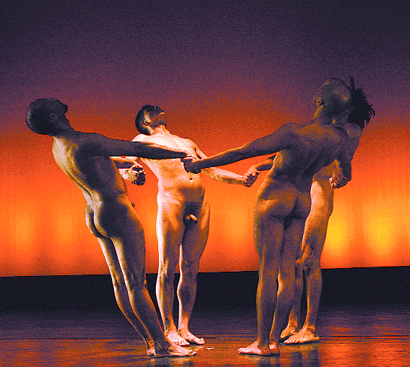Dance Space Center, risking gender critique, highlights male physicality, eroticism
By GUS SOLOMONS JR.
“In the Company of Men” is as powerful a display of male dancing as anything since Ted Shawn and his troupe of scantily men dancers shook things up at Jacob’s Pillow at the dawn of the modern dance era.
In 1993, artistic director Charles Wright, co-director of Dance Space Center, began the series. For this year’s production, dancer/ choreographer/ juggler/sound designer/DJ, and producer Alberto Denis presented works by seven male dance makers at Florence Gould Hall on June 25 and 26. This reviewer has served as editing advisor for two of these choreographers, but not for the dances presented in this program.
Lately, male choreographers have come under attack by The Gender Project, a coalition of female choreographers, who claim that men receive a disproportionate share of opportunity in the undernourished world of concert dance. At the risk of sounding chauvinistic, I find male physicality used in artistic movement irresistible, be it ballet, modern dance, or gymnastics. (On the other hand, it’s women figure skaters that float my boat.) And, like it or not, until the predilection of American audiences for increasingly greater physical virtuosity runs its course, young men have the genetic upper hand at crowd pleasing in that respect.
The show begins with excerpts from “The Mattress Suite,” a solo by Larry Keigwin, followed by a trio by Keigwin, Alexander Gish, and Kevin Scarpin, both presented on a double-size mattress. White jockey shorts displayed perfect bodies, as the trio playfully explored the physicality of a sexual three-way, which ended with one player getting dressed and leaving.
In Nicholas Leichter’s “Discretion,” the choreographer and Jared Kaplan had a poignant push-me, pull-you relationship. Set to original music by Jonathan Mele, Leichter’s signature disco-driven moves lightly peppered the slow, intense partnering by the two men.
Arthur Aviles upended gender perceptions by confronting us with five nude men—Esteban Arana, Julio Arroyo, Pedro Jimenez, and Pedro Raposo—and a woman, Masako Koga, dressed like a man. In his “Real Men,” Aviles, a big fan of stage nudity since his days with the Bill T. Jones/Arnie Zane Dance Company, didn’t find a kinetic focus that transcends the calculated shock—or delight—of watching attractive naked guys onstage.
In the first of two short solos, “One for Me and One for You,” buttery mover Oliver Steele exposed his strong legs; in the second, his bare chest. In both, he unleashed a barrage of dynamic, if somewhat repetitious motions punched up with startling aerial acrobatics. Lutin Tanner added exciting lighting accents that complemented Steele’s dynamics and dramatics, but the rambling second solo diluted the stronger impact of the first.
Brian Brooks, an alumnus of Elizabeth Streb’s POP Action troupe and a poster boy for killer core strength, relishes hard physical tasks, and his “Propeller” indulged that propensity. Brooks lay on a white floor cloth, whipping his legs, jackknifing his body, and somersaulting like a… well, propeller.
Spanish choreographer Fernando Hurtado and his partners Igor Calonge and Erick Jimenez offered “Lord,” the story of a young man’s coming out, perhaps, and its tragic consequence—suicide.
Although the roles of the three remained inconclusive and the text in Spanish and English was unintelligible, the deeply grounded lunges, slashing limbs, and desperate runs of Hurtado’s richly expressive physical lexicon painted a vivid portrait of confusion, desperation, and torment.
Finally, “Roundup!” popped like a champagne cork, bubbling with delight. Earl Mosley, a permanent faculty member at Dance Space Center, created a series of short, funny vignettes for seven cracker-jack ballet-dancing cowboys—Leo Arpon, Clifton Brown, Jakee Malik Johnson, Nahiko Ishii, Roderick George, Kanji Segawa, and Terrence Poplar—who spun like tops, leapt like gazelles, and played to the house like a Broadway musical comedy ensemble.
The crowd responded enthusiastically in kind.

































